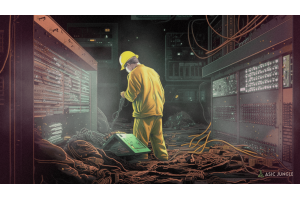Intermittent energy production, common to renewables, is often hampered by insufficient demand from legacy grid infrastructures, leading to stranded (wasted) energy. At the macro level, stranded energy in the industry represents a persistent gap in the market. As we move toward a net-zero energy future, novel solutions are thus required to fill this gap toward optimizing the incentive to produce sustainable energy.
On this path, steadily evolving Bitcoin ASIC mining technologies are emerging as key tools for the job. Deployed through containerized data centres, ASIC machines offer a degree of adaptability to dynamic energy demand that has gone unmatched. Added benefits include decentralization of energy infrastructure, diversified revenue streams, improved heat and electrical energy efficiency, and decreased reliance on monopolized grids.
This article will explore how one organization, GREENTECH Technologies, has been a leading example with their innovative GREENBOX: a modular, containerized data center. The GREENBOX recovers 97% of heat waste by integrating immersion cooling systems and dynamic demand response programs. The optimal thermal efficiency and energy curtailment capabilities of the GREENBOX benefits energy producers, users, and the environment while extending the typical lifespan of ASICs. In the absence of any reasonable competition, GREENTECH has been leading a new way forward.
Asic Magazine closely monitors ASIC technology innovation and has been picking up on the coinciding impact on traditional energy infrastructure. With energy giants like Shell and ERCOT entering the Bitcoin mining space, GREENTECH Technologies is proving that their data centers are at the leading edge in an emerging space. This article reports on achieving energy sustainability, shedding light on a greener future.
Heat recovery
Heat recovery is the process of capturing and reusing waste heat generated via Combined Heat and Power (CHP), also known as Cogeneration, for industrial processes. It is an important part of GREENTECH Technologies' value proposition because they allow their clients to reduce their dependence on fossil fuels and increase overall energy efficiency. Conventional methods for heat recovery are common practice for industrial facilities like commercial greenhouses.
GREENTECH Technologies has taken CHP heat recovery a step further by offering their data centres as a modern green alternative to the electrical boiler in the traditional CHP processes. Their clients gain a means to diversify their revenue streams, improve their bottom line, and often register zero dependence on grid electricity.
Immersion cooling
Immersion cooling is a method for cooling electronics by submerging them in a non-conductive liquid. In the case of GREENTECH, they use immersion cooling to cool the ASICs in their GREENBOX data centers.
Immersion cooling is also practical for more precise temperature control and overclocking, the process of increasing the output rate of a computer (ASIC) beyond its factory settings. The heat dissipating effects of immersion cooling prevents the damaging effects of overheating, meaning that GREENTECH’s data centres can operate above capacity without decreasing their operating life.
The ability to practice overclocking is especially advantageous when the price of Bitcoin is above average. Every unit of ASIC output fetches a higher price, of course, but this also means that more revenue is generated for every unit of heat produced by the ASICs. When the price of Bitcoin is high enough, heat for industrial facilities like greenhouses is produced for effectively zero cost.
The GREENBOX
The GREENBOX is a versatile tool developed by GREENTECH Technologies to help their clients make the most of the electricity output from their on-site CHP generation sets (gensets). It is designed to monetize their clients’ baseload and excess electricity output while recovering heat produced by the GREENBOX itself.
The GREENBOX is a means to make their clients’ facilities increasingly self-sufficient energy systems, reducing fossil fuel use, increasing energy efficiency, and curbing reliance on external grids, all while improving their bottom line. The GREENBOX is a key part of GREENTECH Technologies' value proposition and effectively empowers their clients to become sophisticated microgrid operators.
Where they started, where they’re going
GREENTECH started with a simple question: "how can we bring heat from Bitcoin mining to greenhouses?". From there, they developed a niche product and service offering that meets the heating needs of industrial-sized facilities, reduces carbon emissions, and provides additional streams of revenue. They are now expanding their reach to other industries that require large-scale heating and cooling solutions, such as hospitals, universities, smart cities, waste management facilities, and more.
The GREENTECH team
Jelmer ten Wolde, CEO of GREENTECH, and his team are well-rooted in combined heat and power (CHP) methods, dynamic demand response programs, and the relatively advanced agribusiness industry of the Netherlands.
In our recent interview with Jelmer, he elaborated on the fact that their team brings such a unique mix of technical expertise and relevant experience that what they offer would be very difficult to replicate. Their CTO, for example, is especially experienced when it comes to CHP.
Greenhouses
The GREENTECH team has worked extensively with greenhouse facilities to meet their heating needs and reduce carbon emissions. The GREENBOX has been instrumental in achieving this goal.
A greenhouse demands varying amounts of heat and electricity depending on daily demand cycles, their overall rate of production, and the cost of electricity. By working with greenhouses, GREENTECH was able to quickly prove the viability of their product and service offering for expansion further afield.
Load balancing with dynamic demand response
Implicit to the GREENBOX is that GREENTECH offers a complete heat and electricity load management system for industrial-scale facilities. This is one of the key aspects in GREENTECH’s value proposition.
Referred to as dynamic demand response, they allow their clients to adjust their energy usage in real-time based on changes in demand. This improves energy efficiency, leading to significant cost savings. Overall, GREENTECH's focus on load balancing via dynamic demand response is an important part of their efforts to help their clients become more sustainable and self-sufficient energy systems.
Next generation digital infrastructure
Perhaps one of the most promising benefits behind the type of solutions being applied by GREENTECH is the trend towards developing self-sufficient energy systems. A coinciding benefit of GREENTECH’s GREENBOX is the capacity to implement networks for district heating. District heating is a system for distributing heat to various, typically commercial, locations from a centralized CHP genset.
Some research suggests that district heating with CHP is one of the most cost-effective methods to cut carbon emissions, having one of the lowest carbon footprints of all fossil fuel energy generation plants. With GREENTECH’s GREENBOX, these minimalized carbon footprints are routinely offset to reach net-zero targets.
To reference an example of how GREENTECH’s clients benefit, have a look at this case study.
Supplying green solutions with Asic Jungle
In the journey towards a net-zero energy future, the need for innovative solutions that bridge the gap between intermittent energy production and insufficient demand has become increasingly important. GREENTECH's GREENBOX represents a unique solution to the persistent problem of stranded energy for sustainable energy producers. By optimizing the heat recovery process, the GREENBOX enables their clients to increase their energy efficiency, diversify their revenue streams, and reduce reliance on external grids. With the growing demand for sustainable energy solutions, GREENTECH's innovative approach positions them as leaders in the field.
Moreover, Asic Jungle supplies the ASIC machines that enable these types of green energy projects. As the impact of ASIC technology on traditional energy infrastructure continues to be monitored, Asic Magazine will continue to report on the forefront of this emerging space. If you’re looking to get your own green energy project moving, contact us today.






